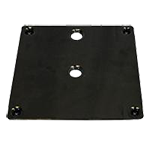A Guide to Pipe & Drape
Pipe and Drape is used to divide, hide, and/or decorate a space temporarily. It is also a great way of adding color to what would normally be a relatively plain backdrop. Pipe and drape is used frequently with home staging, weddings, fashion shows, concerts, interior design, and in the theatre.

1) Base : Used to stabilize the framework, bases will determine what uprights and system is used. If time is a factor, use "Slip-Fit" for easy setup and breakdown. If buying in bulk for trade shows use the "Screw-In" system which saves storage space and is best for more permanent setups.
2) Upright : These are pipes or poles that stand vertically in a drape setup. They are available in fixed heights or telescoping for adjustable heights. If you are new to Pipe & Drape, we recommend starting with the industry standard, fixed height 8' uprights. You can always add to the setup as your need grows. If you want to go taller simply use Upright Extensions to get an additional 2', 4' or 6' to an exisiting upright. As the system gets taller, Base Weights are recommended.
3) Drape Support : Also known as "crossbars" or "horizontal rods", they are the piece that you hang your drapes from, and sets the width of your display. The most popular Drape Support to get started with is the 6'-10' Premier Drape Support, because it gives you a variety of width options.
4) Drape : Most companies start out with Poly Premier fabric which has flat, professional finish at an affordable price point. Banjo Drape is also available at an even lower price. Performance Velour is recommended as the highest quality fabric, and is a 100% blackout fabric guaranteed to block incoming light. A low cost alternative to velour is our Commando Cloth Drapes for use as a blackout with a felt-like finish. Sheer Fabric Drapes are popular for weddings and special events.







